CRM文献综述
- 格式:doc
- 大小:138.50 KB
- 文档页数:6

客户关系管理文献综述二、客户关系管理的概念与内涵客户关系管理是指企业通过对客户的识别、分类、分析、挖掘和管理,建立与客户之间长期稳定的关系,以提高客户满意度、提升企业竞争力和市场占有率的一种管理方式。
客户关系管理的核心是关系营销,即通过建立和维护好的客户关系,实现企业与客户之间的互利共赢。
同时,客户关系管理还包括了客户信息管理、客户服务管理、客户投诉管理、客户满意度管理等多个方面,以全方位地满足客户需求。
三、企业客户关系管理的应用研究企业客户关系管理的应用研究主要包括以下几个方面:客户关系管理系统的建立、客户关系管理的组织架构和流程设计、客户关系管理的实施和运营、客户关系管理的效果评估等。
客户关系管理系统的建立是企业实施客户关系管理的基础,需要根据企业的实际需求和客户特点,选择适合的客户关系管理系统。
同时,企业还需要根据客户关系管理的要求,调整组织架构和流程设计,明确责任和权限,确保客户关系管理的顺利实施和运营。
最后,企业需要对客户关系管理的效果进行评估,及时调整和改进客户关系管理策略。
四、客户关系管理的理论研究状况客户关系管理的理论研究主要包括以下几个方面:客户关系管理的概念和内涵、客户关系管理的影响因素、客户关系管理的实施策略、客户关系管理的效果评估等。
客户关系管理的研究已经形成了一些比较成熟的理论体系,如关系营销理论、数据挖掘理论、客户生命周期理论等。
此外,客户关系管理的研究也在不断发展和完善中,如客户关系管理与社交媒体的结合、客户关系管理与大数据的应用等,这些都将进一步推动客户关系管理理论的发展和创新。
结论客户关系管理作为一种管理方式和理论体系,已经得到了广泛的应用和研究。
未来,客户关系管理将继续发挥重要作用,随着信息技术的不断发展和应用,客户关系管理也将不断创新和完善,为企业提供更加优质的客户服务和更加高效的管理方式。
客户关系管理的理论基础源于西方市场营销理论。
XXX总结了营销观念发展的五个演变阶段,前三个是传统营销观念,后两个是现代市场营销观念。
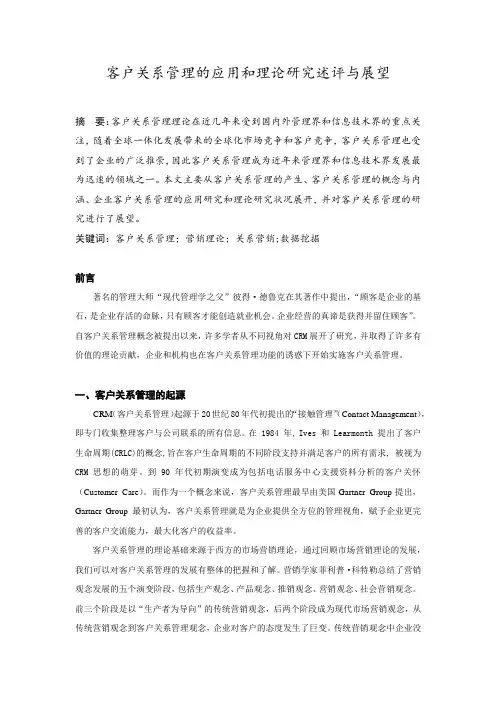
客户关系管理的应用和理论研究述评与展望摘要:客户关系管理理论在近几年来受到国内外管理界和信息技术界的重点关注,随着全球一体化发展带来的全球化市场竞争和客户竞争,客户关系管理也受到了企业的广泛推崇,因此客户关系管理成为近年来管理界和信息技术界发展最为迅速的领域之一。
本文主要从客户关系管理的产生、客户关系管理的概念与内涵、企业客户关系管理的应用研究和理论研究状况展开,并对客户关系管理的研究进行了展望。
关键词:客户关系管理;营销理论;关系营销;数据挖掘前言著名的管理大师“现代管理学之父”彼得·德鲁克在其著作中提出,“顾客是企业的基石,是企业存活的命脉,只有顾客才能创造就业机会。
企业经营的真谛是获得并留住顾客”。
自客户关系管理概念被提出以来,许多学者从不同视角对CRM展开了研究,并取得了许多有价值的理论贡献,企业和机构也在客户关系管理功能的诱惑下开始实施客户关系管理。
一、客户关系管理的起源CRM(客户关系管理)起源于20世纪80年代初提出的“接触管理”(Contact Management),即专门收集整理客户与公司联系的所有信息。
在 1984 年, Ives 和 Learmonth 提出了客户生命周期(CRLC)的概念,旨在客户生命周期的不同阶段支持并满足客户的所有需求, 被视为CRM 思想的萌芽。
到90年代初期演变成为包括电话服务中心支援资料分析的客户关怀(Customer Care)。
而作为一个概念来说,客户关系管理最早由美国Gartner Group提出,Gartner Group 最初认为,客户关系管理就是为企业提供全方位的管理视角,赋予企业更完善的客户交流能力,最大化客户的收益率。
客户关系管理的理论基础来源于西方的市场营销理论,通过回顾市场营销理论的发展,我们可以对客户关系管理的发展有整体的把握和了解。
营销学家菲利普·科特勒总结了营销观念发展的五个演变阶段,包括生产观念、产品观念、推销观念、营销观念、社会营销观念。
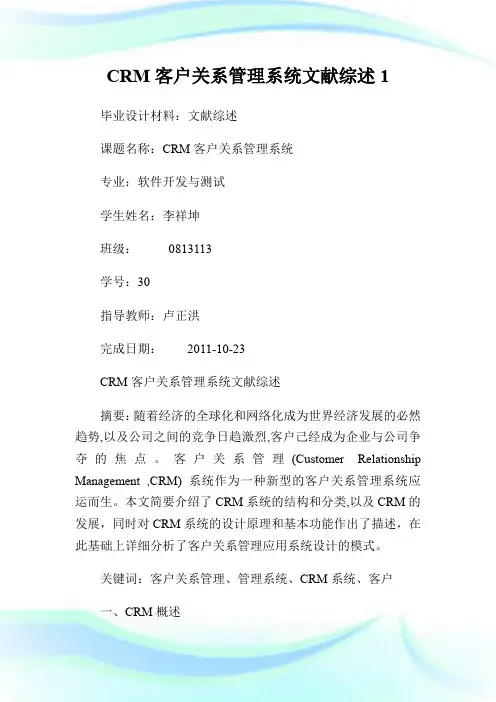
CRM客户关系管理系统文献综述1毕业设计材料:文献综述课题名称:CRM客户关系管理系统专业:软件开发与测试学生姓名:李祥坤班级:0813113学号:30指导教师:卢正洪完成日期:2011-10-23CRM客户关系管理系统文献综述摘要:随着经济的全球化和网络化成为世界经济发展的必然趋势,以及公司之间的竞争日趋激烈,客户己经成为企业与公司争夺的焦点。
客户关系管理(Customer Relationship Management ,CRM) 系统作为一种新型的客户关系管理系统应运而生。
本文简要介绍了CRM系统的结构和分类,以及CRM的发展,同时对CRM系统的设计原理和基本功能作出了描述,在此基础上详细分析了客户关系管理应用系统设计的模式。
关键词:客户关系管理、管理系统、CRM系统、客户一、CRM概述1、CRM的体系结构CRM是一种旨在改善企业与客户之间关系的管理机制,利用现代信息技术,在企业和客户之间建立一种数字、实时、互动的交流管理系统[1 ] 。
从逻辑模型角度来讲,一个完整的CRM 系统分为三个层次:界面层、功能层和支持层。
其中,界面层是用户与系统之间进行交互、获取或输入信息的接口。
通过直观的、简便易用的前台界面,为各项用户操作提供方便。
功能层是由各种功能模块构成,包括销售自动化、营销自动化、客户支持与服务、呼叫中心、电子商务以及辅助决策等功能模块,执行CRM的各项基本功能。
支持层是保证整个系统正常运行的基础,通常包括数据库管理系统、网络通信协议等。
2、CRM分类通常,CRM 系统分为操作型、分析型和协作型三类。
(1)运营型CRM。
运营型CRM为分析和客户的服务支持提供依据。
运营型CRM 收集大量的客户信息、市场活动信息和客户服务的信息,使得销售、市场、服务一体化、规范化和流程化,主要包括销售、市场和服务三个过程的流程化、规范化、自动化和一体化。
在销售方面,包括销售信息管理、销售过程定制、销售过程监控等。

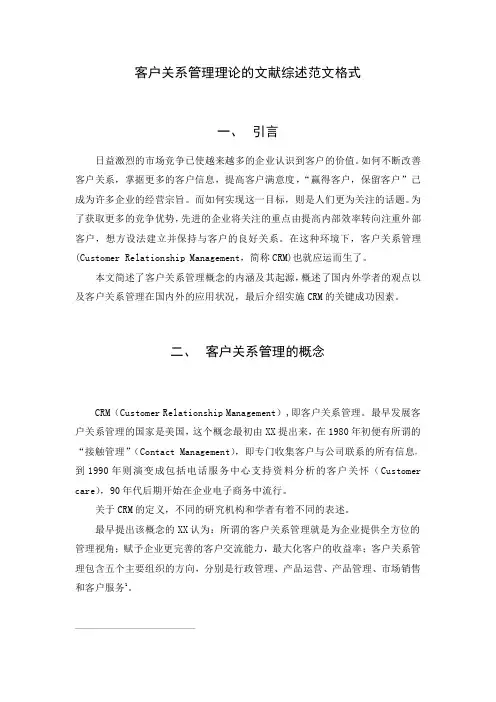
客户关系管理理论的文献综述范文格式
一、引言
日益激烈的市场竞争已使越来越多的企业认识到客户的价值。
如何不断改善客户关系,掌据更多的客户信息,提高客户满意度,“赢得客户,保留客户”己成为许多企业的经营宗旨。
而如何实现这一目标,则是人们更为关注的话题。
为了获取更多的竞争优势,先进的企业将关注的重点由提高内部效率转向注重外部客户,想方设法建立并保持与客户的良好关系。
在这种环境下,客户关系管理(Customer Relationship Management,简称CRM)也就应运而生了。
本文简述了客户关系管理概念的内涵及其起源,概述了国内外学者的观点以及客户关系管理在国内外的应用状况,最后介绍实施CRM的关键成功因素。
二、客户关系管理的概念
CRM(Customer Relationship Management),即客户关系管理。
最早发展客户关系管理的国家是美国,这个概念最初由XX提出来,在1980年初便有所谓的“接触管理”(Contact Management),即专门收集客户与公司联系的所有信息,到1990年则演变成包括电话服务中心支持资料分析的客户关怀(Customer care),90年代后期开始在企业电子商务中流行。
关于CRM的定义,不同的研究机构和学者有着不同的表述。
最早提出该概念的XX认为:所谓的客户关系管理就是为企业提供全方位的管理视角;赋予企业更完善的客户交流能力,最大化客户的收益率;客户关系管理包含五个主要组织的方向,分别是行政管理、产品运营、产品管理、市场销售和客户服务1。
(本文章版权归作者所有,更多客户关系管理理论的文献综述范文格式请浏览
)。
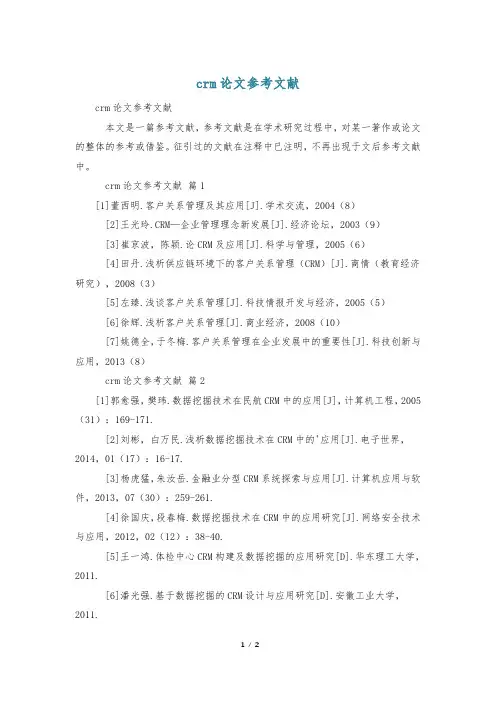
crm论文参考文献crm论文参考文献本文是一篇参考文献,参考文献是在学术研究过程中,对某一著作或论文的整体的参考或借鉴。
征引过的文献在注释中已注明,不再出现于文后参考文献中。
crm论文参考文献篇1[1]董西明.客户关系管理及其应用[J].学术交流,2004(8)[2]王光玲.CRM—企业管理理念新发展[J].经济论坛,2003(9)[3]崔京波,陈颖.论CRM及应用[J].科学与管理,2005(6)[4]田丹.浅析供应链环境下的客户关系管理(CRM)[J].商情(教育经济研究),2008(3)[5]左臻.浅谈客户关系管理[J].科技情报开发与经济,2005(5)[6]徐辉.浅析客户关系管理[J].商业经济,2008(10)[7]姚德全,于冬梅.客户关系管理在企业发展中的重要性[J].科技创新与应用,2013(8)crm论文参考文献篇2[1]郭愈强,樊玮.数据挖掘技术在民航CRM中的应用[J],计算机工程,2005(31):169-171.[2]刘彬,白万民.浅析数据挖掘技术在CRM中的'应用[J].电子世界,2014,01(17):16-17.[3]杨虎猛,朱汝岳.金融业分型CRM系统探索与应用[J].计算机应用与软件,2013,07(30):259-261.[4]徐国庆,段春梅.数据挖掘技术在CRM中的应用研究[J].网络安全技术与应用,2012,02(12):38-40.[5]王一鸿.体检中心CRM构建及数据挖掘的应用研究[D].华东理工大学,2011.[6]潘光强.基于数据挖掘的CRM设计与应用研究[D].安徽工业大学,2011.crm论文参考文献篇3[1]廖雯.基于客户生命周期的CRM策略研究[J].商,2015(17):15-15.[2]陈杭.电子商务的营销资源在CRM策略中有效分配探讨[J].现代商业,2015(11):42-43.[3]金子琦.纷享销客中国式CRM商业逻辑大复盘[J].创业邦,2015(10):90-91.[4]姚婷.探析客户关系管理系统对中国创意产业园运营模式的指导意义[J].中国市场,2015(27):59-61.[5]朱华玉.湖南铁道职业技术学院CRM实践研究[J].辽宁高职学报,2015,17(7);19-21。
![基于仿真模拟的CRM系统设计及实现[文献综述]](https://uimg.taocdn.com/6c41a5684afe04a1b071de97.webp)
(2011届)毕业论文(设计)文献综述题目: 基于仿真模拟的CRM系统设计及实现学院:商学院专业:信息管理与信息系统班级:学号:姓名:指导教师:一、前言部分1、写作目的基于仿真模拟的CRM系统设计的基本思路是采用仿真方式模拟CRM的各种先进理念、操作流程及相关知识[1]。
以客户为核心,寻找客户、预约客户、培养客户并向培养成熟的客户进行产品推销,产品销售完成后进行一系列的客户维护活动;并结合仿真的方式,让学生在相同总资金情况下,以角色扮演的方式,对系统所提供的客户进行分析,并采取一系列的预约、培养、推销、维护等行为,对经营数据量化,根据总评价来判断模拟运营成绩,创造使模拟公司充分发挥潜在能动性的模拟环境[2],从而达到让学员了解客户关系管理的目的。
2、有关概念介绍(1)仿真模拟所谓仿真模拟,即是外形仿真、操作仿真、视觉感受仿真,使用真实的模型或其他等比例的模型作为参与者的操控平台,通过实际操作,使参与者有身临其境的切身体会。
最后对仿真结果进行科学的分析,得出正确、有效地结论[3]。
(2)客户关系管理系统客户关系管理系统(crm)是利用信息科学技术,实现市场营销、销售、服务等活动自动化,是企业能更高效地为客户提供满意、周到的服务,以提高客户满意度、忠诚度为目的的一种管理经营方式[4]。
客户关系管理既是一种管理理念,又是一种软件技术。
以客户为中心的管理理念是CRM实施的基础。
CRM系统可以帮助企业搜集、跟踪和分析每一个客户的信息 ,从而知道什么样的客户需要什么东西 ,同时还能观察和分析顾客行为对企业收益的影响 ,使企业和客户的关系及企业利润得到最优化[5]。
(3)技术ASP是一项微软公司的技术,是一种使嵌入网页中的脚本可由因特网服务器执行的服务器端脚本技术。
指 Active Server Pages(动态服务器页面),运行于IIS 之中的程序。
3、综述范围基于仿真模拟的CRM系统设计主要是采用仿真的方式来模拟客户关系管理各项操作的系统,从仿真模拟、客户关系管理系统、技术三个方面来进行综述。
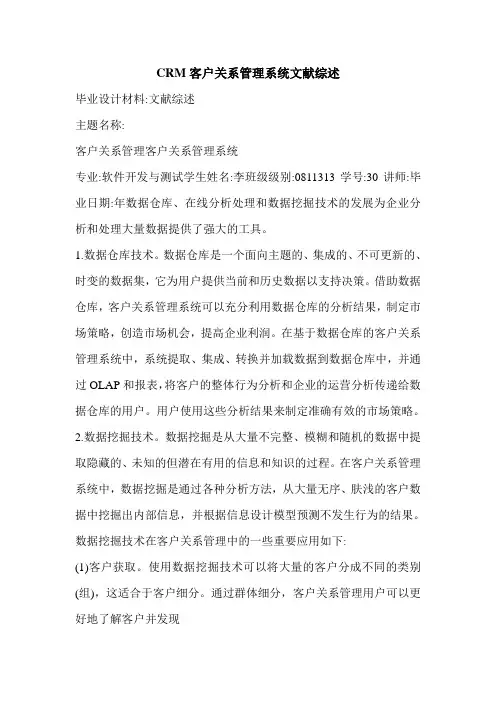
CRM客户关系管理系统文献综述毕业设计材料:文献综述主题名称:客户关系管理客户关系管理系统专业:软件开发与测试学生姓名:李班级级别:0811313学号:30讲师:毕业日期:年数据仓库、在线分析处理和数据挖掘技术的发展为企业分析和处理大量数据提供了强大的工具。
1.数据仓库技术。
数据仓库是一个面向主题的、集成的、不可更新的、时变的数据集,它为用户提供当前和历史数据以支持决策。
借助数据仓库,客户关系管理系统可以充分利用数据仓库的分析结果,制定市场策略,创造市场机会,提高企业利润。
在基于数据仓库的客户关系管理系统中,系统提取、集成、转换并加载数据到数据仓库中,并通过OLAP和报表,将客户的整体行为分析和企业的运营分析传递给数据仓库的用户。
用户使用这些分析结果来制定准确有效的市场策略。
2.数据挖掘技术。
数据挖掘是从大量不完整、模糊和随机的数据中提取隐藏的、未知的但潜在有用的信息和知识的过程。
在客户关系管理系统中,数据挖掘是通过各种分析方法,从大量无序、肤浅的客户数据中挖掘出内部信息,并根据信息设计模型预测不发生行为的结果。
数据挖掘技术在客户关系管理中的一些重要应用如下:(1)客户获取。
使用数据挖掘技术可以将大量的客户分成不同的类别(组),这适合于客户细分。
通过群体细分,客户关系管理用户可以更好地了解客户并发现全面的客户行为和集团客户行为规则,制定相应的市场策略。
同时,通过对不同客户群的交叉分析,企业可以发现客户群的变化规律。
(2)发现关键客户。
关键客户发现是发现对企业有重要意义的客户。
主要客户包括:有价值的潜在客户;有更多消费需求的同一客户;更多的客户使用相同的产品或服务;需要保持忠诚度的客户。
关键客户发现在客户关系管理中起着重要作用。
(3)客户流失分析。
判断哪些客户群最有可能丧失哪些特征,有助于企业提前为面临损失风险的客户采取相应的营销措施。
利用分类技术建立预测模型,更准确地识别弱势客户群体,并制定相应的方案,最大限度地维护老客户。
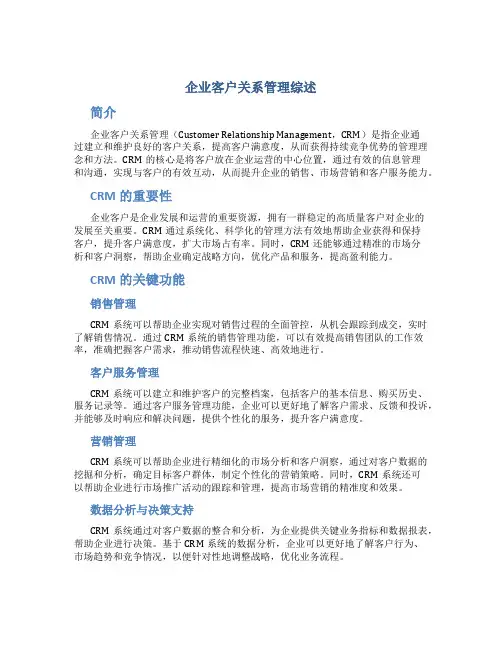
企业客户关系管理综述简介企业客户关系管理(Customer Relationship Management,CRM)是指企业通过建立和维护良好的客户关系,提高客户满意度,从而获得持续竞争优势的管理理念和方法。
CRM的核心是将客户放在企业运营的中心位置,通过有效的信息管理和沟通,实现与客户的有效互动,从而提升企业的销售、市场营销和客户服务能力。
CRM的重要性企业客户是企业发展和运营的重要资源,拥有一群稳定的高质量客户对企业的发展至关重要。
CRM通过系统化、科学化的管理方法有效地帮助企业获得和保持客户,提升客户满意度,扩大市场占有率。
同时,CRM还能够通过精准的市场分析和客户洞察,帮助企业确定战略方向,优化产品和服务,提高盈利能力。
CRM的关键功能销售管理CRM系统可以帮助企业实现对销售过程的全面管控,从机会跟踪到成交,实时了解销售情况。
通过CRM系统的销售管理功能,可以有效提高销售团队的工作效率,准确把握客户需求,推动销售流程快速、高效地进行。
客户服务管理CRM系统可以建立和维护客户的完整档案,包括客户的基本信息、购买历史、服务记录等。
通过客户服务管理功能,企业可以更好地了解客户需求、反馈和投诉,并能够及时响应和解决问题,提供个性化的服务,提升客户满意度。
营销管理CRM系统可以帮助企业进行精细化的市场分析和客户洞察,通过对客户数据的挖掘和分析,确定目标客户群体,制定个性化的营销策略。
同时,CRM系统还可以帮助企业进行市场推广活动的跟踪和管理,提高市场营销的精准度和效果。
数据分析与决策支持CRM系统通过对客户数据的整合和分析,为企业提供关键业务指标和数据报表,帮助企业进行决策。
基于CRM系统的数据分析,企业可以更好地了解客户行为、市场趋势和竞争情况,以便针对性地调整战略,优化业务流程。
CRM的实施策略企业实施CRM系统需要考虑以下几个关键方面:目标明确企业需要明确CRM系统实施的目标,明确希望通过CRM系统实现的效益和目标,比如提高销售额、提升客户满意度等。
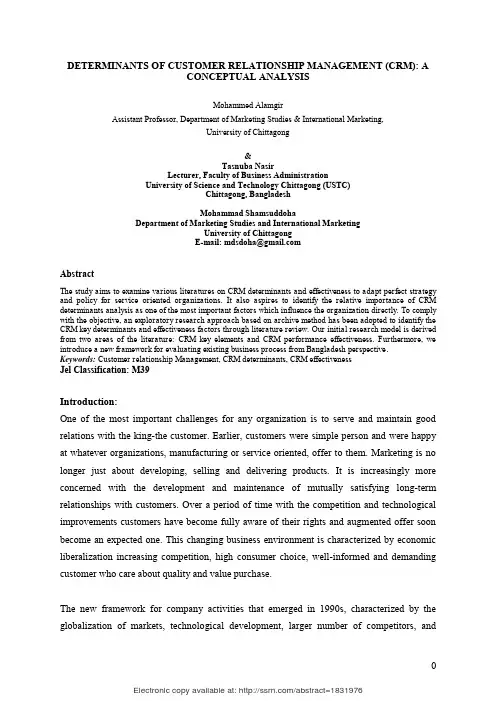
DETERMINANTS OF CUSTOMER RELATIONSHIP MANAGEMENT (CRM): ACONCEPTUAL ANALYSISMohammed AlamgirAssistant Professor, Department of Marketing Studies & International Marketing,University of Chittagong&Tasnuba NasirLecturer, Faculty of Business AdministrationUniversity of Science and Technology Chittagong (USTC)Chittagong, BangladeshMohammad ShamsuddohaDepartment of Marketing Studies and International MarketingUniversity of ChittagongE-mail: mdsdoha@AbstractThe study aims to examine various literatures on CRM determinants and effectiveness to adapt perfect strategy and policy for service oriented organizations. It also aspires to identify the relative importance of CRM determinants analysis as one of the most important factors which influence the organization directly. To comply with the objective, an exploratory research approach based on archive method has been adopted to identify the CRM key determinants and effectiveness factors through literature review. Our initial research model is derived from two areas of the literature: CRM key elements and CRM performance effectiveness. Furthermore, we introduce a new framework for evaluating existing business process from Bangladesh perspective. Keywords: Customer relationship Management, CRM determinants, CRM effectivenessJel Classification: M39Introduction:One of the most important challenges for any organization is to serve and maintain good relations with the king-the customer. Earlier, customers were simple person and were happy at whatever organizations, manufacturing or service oriented, offer to them. Marketing is no longer just about developing, selling and delivering products. It is increasingly more concerned with the development and maintenance of mutually satisfying long-term relationships with customers. Over a period of time with the competition and technological improvements customers have become fully aware of their rights and augmented offer soon become an expected one. This changing business environment is characterized by economic liberalization increasing competition, high consumer choice, well-informed and demanding customer who care about quality and value purchase.The new framework for company activities that emerged in 1990s, characterized by the globalization of markets, technological development, larger number of competitors, andincreased customer demands compelled companies to rethink their management systems to adapt fit themselves to the new competitive environment. Because of rigorous competition, in recent years, many organizations have perceived the need to be more customer-orientated. (Bull, 2003).CRM is more evolution than revolution. Thus, achieving the full potential of each customer relationship should be the major goal of every business. A dissatisfied customer causes market damage because they are more likely to persuade others to defect. It is therefore no surprise that CRM is an important topic of conversation in business world (Feinberg et .al., 2002). Albeit customers are the important factors for the success of business but lees attention has been given in this regard. On the other hand, several strategies have been attempted to retain customers by the private commercial banks of Bangladesh but there is a problem with factors identification and specific framework of CRM. Keeping this fact in mind, the proposed research will attempt to explore the CRM issues and its determinants as well as its impact on customer acquisition and retention process and thus finally develop a framework of customer relationship Management for bank customers.Objectives of the study:Due to the rapid speed of Globalization and increased competition both from local and international companies, the importance of CRM has increased. To be successful in the market firms have to developed strategies based on present market as well as customer requirement. This makes it interesting how companies manage the issue.The principal objective is to evaluate literature on CRM which has been developed by the different researchers that is applicable to different kind of organizations. To accomplish this, the study has covered the following specific objectives:1.To identify the Key elements of CRM2.To identify the factors related to CRM effectiveness3.To find out possible approach to examine Customer relationship dimensions4.To propose an instrument concerning determinants and effectiveness of CRMRationale of the study:Albeit customers are the important factors for the success of business but lees attention has been given in this regard. On the other hand, managing customer relationship should bepractice oriented rather than conceptualize. But various researchers pointed out various determinants and it also varies organization to organization and so does the outcome.Differences in the extent of use of CRM exist across countries. Compared with developed countries, use of CRM in Bangladesh is relatively new. It is important for practitioners’ as well as academicians to know these elements critically and their importance and usefulness in a way to achieve good organizational outcomes. It is also important for us to know the integrated approaches of CRM (combining the effective and efficient blend of managerial issues and IT issues) as it is very important for Bangladeshi business sector, especially in the service organization so that both organization and customers individually and society as a whole can reap benefit.Keeping this fact in mind, the proposed research will attempt to explore the CRM issues and its determinants thus finally develop a conceptual framework of customer relationship Management.Methodology of the StudyThe study has covered various literatures on Customer relationship Management dimensions based on developed countries. A Library research method (Archive) has been used in this study. Different books, journals, periodicals and online papers have been observed by the researchers to find out different issues in CRM dimensions in this connection. Mostly secondary data has been compiled in this study and this data has been collected from focused countries literatures, textbooks, e-journals, government publications etc.Customer Relationship Management:CRM has become one of the most dynamic topics of the new millennium. CRM is basically a remarkable step forward in creating a system that can provide a way of keeping hold of individual loyalty. In order to comply with the concept of CRM one must also understand the changing nature of the customers because they are not what they used to be (Greenberg, 2001). Thus, CRM initiatives must address relevant organizational factors as well as the extra-organizational environmental factors (carol & Banarjee, 2009).Since the area is quite new and still under development, there is no universal explanation of CRM. Therefore it is important to know what CRM is all about according to the academicresearchers and how many organizations adapt the definition to their own business and their unique needs (Wilson, et al., 2002). It can be defined in the following ways-“CRM is the infrastructure that enables the delineation of increase in customer value, and the correct means by which to motivate valuable customers to remain loyal-indeed, t o buy again” (Dyche, 2001, p4). “CRM is about managing customer knowledge to be understood and serve them and it is a multi-dimensional concept which places customers at the centre of an organization where customer service is an important component of CRM; however this notion is also concerned with coordinating customer rela tions across all business functions” (Bose & Sugamaran, 2003, p.4). CRM is a customer oriented business strategy that aims to increase customer satisfaction and customer loyalty by offering a more responsive and customized service to each customer (Fayerman, 2002)It can also be defined in the following way—“CRM is enterprise-wide mindset, mantra, and set of business process and policies that are designed to acquire, retain and service customer. CRM is not a technology, though technology is a CRM enable r” (Greenberg, 2001, p.14)Determinants of CRMAccording to Karakostas et. al., (2005) the factors that influence the CRM implementation are new customer attraction, consumer buying behavior, competitive advantage, customer satisfaction, customer retention, acquisition, long-term relationship, knowledge management, web-enabled customer service, customer value, etc. On the other hand, other researchers like Mendoza et. al,. (2006) pointed out that IT, long-term relationship, higher profitability, significant investment in technology are the factors influencing CRM.Gefen & Riding (2002) divided CRM into three folds: Operational, analytical, and collaborative. Operational CRM, known as front-office CRM, enables communications and involves the areas where direct customer contact occurs. Operational CRM attempts to provide integration of back-office transactions with customer interfaces. Collaborative CRM is the communication centre and it is also the coordination network that provides the neural paths to the customer and supplier.On the other hand, Customer Relationship Management (CRM) has been increasingly adopted by corporations as a core IT driven business strategy and firms have started to investheavily in CRM (Reinartz et. al., 2004). Academics and practitioners have tried to find the drivers of CRM success or failure with their own perspectives for many years. While some researches focused more on IT related factors, others emphasized organizational factors like human resources, organizational structures, and reward systems (Rigby et. al.,2002) or business process-related factors (Reinartz et. al., 2004).The above factors pointed out by different researchers basically cover the three key aspects of every CRM strategy which include human factor, processes, and technology.Bohling et. al., pointed out some critical success factors for CRM implementation and their proposed model is as follows-Fig 1: CRM implementation model, Bohling et. al., (2006) p. 188On the other hand, Lindgreen et. al., (2006) pointed out ten critical aspects of CRM implementation which are- people, culture, relationship management process, knowledge management, IT, organization, brand strategy, customer strategy, customer interaction strategy, and value creation strategy.Kim et. al., (2003) believes that performance measurement is so powerful in enhancing business performance. Various researchers proposed various framework for evaluating CRMeffectiveness. Bohling et. al., (2006) suggest five factors namely, proven customer impact in terms of retention and satisfaction, quantifiable revenue growth, improved information and insights, quantifiable cost reduction, improved employee productivity, etc. For evaluating CRM effectiveness Kim et. al., (2003) proposed a very comprehensive model which is as follows,Fig 2: Model for evaluation of CRM (Source: Kim et. al., (2003) p.14)CRM is a complex term that requires several aspects of the organizations and it can not be reduced to only one of theses aspects where majority of the early researchers either continued with managerial issues or IT issues. According to the above discussion of various determinants of service quality, it is found that different authors have proposed differentdeterminants of CRM. For having a quick look, all determinants as well as effectiveness of CRM proposed by different authors mentioned above are shown in the following table.Based on the above literature the initial research model can be developed which will incorporate Key CRM elements in one side and CRM effectiveness in the other side and the framework is as followsFig: proposed framework for CRM determinants and its effectivenessConcluding RemarksThis paper focused on CRM issues in the developed countries which can be a guideline for our fastest growing service industry. As various organizations are approaching, especially service industry is growing very quickly, the respective authorities have to give careful attention regarding discussed CRM determinants in order to minimize the expectation-perception gap as well as ensure better and quality service. This paper analyses different literatures on key elements of CRM. It is clear that those literature have been discussed based on some elements which is directly related with the CRM issues and these issues are equivalently important for an organization for sustainable growth of their profitability. In this paper the researchers also propose a model of CRM determinants along with their effectiveness instruments on the basis of the earlier research work, which can be followed by Bangladeshi organizations, especially the service sectors to promote true quality service. Moreover, this model can be guideline for the top level managers to understand the different aspects of CRM dimensions so that they can be able to choose the right dimensions and instruments to offer competitive service for the sake of holding sustainable growth and profitability of the organizations.References:1.Bohling, T., Bowman, D., LaValle, S., Mittal, V., Narayandas, D., Ramani, G. & Varadarajan, R.(2006). CRM implementation: effectiveness issues and insights. Journal of Service Research, 9(2), 184-1942.Bose, R., & Sugumaran, V. (2003). Application of Knowledge Management Technology in CustomerRelationship Management. Knowledge and Process Management, 10 (1), 3-17.3.Bull, C. (2003), ‘strategic issues in customer relationship management’, Busin ess processManagement Journal, 9:5, 592-6024.Carol, O.X., Banarjee, P.K. (2009). Determinants of successful customer relationship management.Journal of Information Technology Management. XX (1): 56-66.5.Chen, I.J. & Popovich, K. (2003). Understanding customer relationship management (CRM): People,Process and Technology. Business Process Management, 19(5), 672-6886.Dyche, J. (2001). The CRM handbook: A Business guide to customer relationship management.London. 1st edition-Wesley Educational publisher Inc.7.Feinberg, R., Kadam, R., Hokama, L., & Kim, I. (2002). The state of electronic customer relationshipin retailing: International Journal of Retail & Distribution Management.8.Fayerman, M., (2002). Customer relationship Management. New Directions For InstitutionalResearch. 1 (13), 57-679.Gefen, D. & Ridings, C.M. (2002). Implementation team responsiveness and user evaluation ofcustomer relationship management: A quasi-experimental design study of social exchange theory.Journal of management Information System. 19 (1), 47-6910.Greenberg, P. (2001). CRM at the speed of light: Capturing and keeping Customers in Internet RealTime. Berkeley: Osborne/McGraw-Hill.11.Jayachandran, S., Sharma, S., Kaufman, P., & Raman, P. (2005). The Role of Relational InformationProcesses and Technology Use in Customer Relationship Management. Journal of Marketing, 69 (4), 177-192.12.Kim, J., Suh, E. & Hwang, H. (2003). A model for evaluating the effectiveness of CRM using theBalanced Scorecard. Journal of Interactive Marketing, 17 ( 2), 5-19.13.Kirby, J., (2001). CRM program Management: the art of change, in: presentations of the conferenceon Making the Vision a Reality, Gartner Group, Paris, France.14.Karakostas, B., Kardaras, D., and Papathanassiou, E. (2005). The state of CRM adoption by thefinancial services in the UK: An empirical investigation. Information & Management, 42, 853-863 15.Lindgreen A., Palmer, R., Vanhamme, J. and Wouters, J. (2004). The design, implementation, andmonitoring of a CRM program: A case study. Marketing Intelligence and Planning. 22(2): 160-186. 16.Mendoza, L. E., Marius, A., Perez, M., & Griman, A.C, (2006). Critical success factors for a customerrelationship Management strategy, Information and Software Technology. Doi: 10.101617.Rigby, D.K., Reichheld, F.F., & Schefter, P. (2002). Avoid the four perils of CRM, Harvard BusinessReview, 80, 101-10918.Reynolds, J. (2002). A Practical Guide to CRM: Building more profitable customer relationships. CMBBooks: New York.19.Reinartz,W., Krafft, M., and Hoyer, W. D. (2004).The Customer Relationship Management Process:Its Measurement and Impact on Performance. Journal of Marketing Research. 293-305.20.Wilson, H., Daniel, E. and McDonald, M. (2002). Factors for success in CRM systems. Journal ofMarketing Management. 18(1): 193-21921.Williams, T. J., Nozick, L. K., Sansalone, M. J., Poston, & R. W. (2006). Sampling Techniques forEvaluating Large Concrete Structures. ACI structural Journal (Technical Paper), 103(42), 399-408。

客户关系管理一、客户关系管理的含义客户关系管理(CRM,Customer Relationship Management),是指通过培养企业的最终客户、分销商和合作伙伴对企业及其产品更积极的偏爱和喜好,留住他们并以此提升企业业绩的一种营销策略。
CRM从广泛的意义上讲是指:在企业的运营过程终不断累积客户信息,并使用获得的客户信息来制定市场战略以满足客户个性化需求。
CRM意味着观念的转变,开始以客户为中心。
我们从上面的定义可以看出,强调客户为中心,强调CRM不仅仅是能满足客户所有需要的技术。
因为CRM不仅是一个系统,一个技术方解决方案,而更加是一种管理思想,这种观念的转变终将影响到CRM实施的全过程。
二、客户关系管理的功能客户关系管理的功能可以归纳为三个方面:市场营销中的客户关系管理、销售过程中的客户关系管理、客户服务过程中的客户关系管理,以下简称为市场营销、销售、客户服务。
(1)市场营销。
客户关系管理系统在市场营销过程中,可有效帮助市场人员分析现有的目标客户群体,如主要客户群体集中在哪个行业、哪个职业、哪个年龄层次、哪个地域等等,从而帮助市场人员进行精确的市场投放。
客户关系管理也有效分析每一次市场活动的投入产出比,根据与市场活动相关联的回款记录及举行市场活动的报销单据做计算,就可以统计出所有市场活动的效果报表。
(2)销售。
销售是客户关系管理系统中的主要组成部分,主要包括潜在客户、客户、联系人、业务机会、订单、回款单、报表统计图等模块。
业务员通过记录沟通内容、建立日程安排、业务阶段划分等功能又可以有效帮助管理人员提高整个公司的成单率、缩短销售周期,从而实现最大效益的业务增长。
(3)客户服务。
客户服务主要是用于快速及时的获得问题客户的信息及客户历史问题记录等,这样可以有针对性并且高效的为客户解决问题,提高客户满意度,提升企业形象。
主要功能包括客户反馈、解决方案、满意度调查等功能。
应用客户反馈中的自动升级功能,可让管理者第一时间得到超期未解决的客户请求,解决方案功能使全公司所有员工都可以立刻提交给客户最为满意的答案,而满意度调查功能又可以使最高层的管理者随时获知本公司客户服务的真实水平。
文献综述客户关系管理(Customer Relationship Management, CRM)是一个不断加强与顾客交流,不断了解顾客需求,并不断对产品及服务进行改进和提高以满足顾客的需求的连续的过程。
其内含是企业利用信息技术(IT)和互联网技术实现对客户的整合营销,是以客户为核心的企业营销的技术实现和管理实现。
客户关系管理注重的是与客户的交流,企业的经营是以客户为中心,而不是传统的以产品或以市场为中心。
为方便与客户的沟通,客户关系管理可以为客户提供多种交流的渠道。
陈利在【浅谈企业客户关系管理】中指出。
CRM 是一套先进的管理思想及技术手段,它通过将人力资源、业务流程与专业技术进行有效的整合,最终为企业涉及到客户或消费者的各个领域提供了完美的集成,使得企业可以更低的成本、更高效率地满足客户的要求。
易正伟在【客户关系管理理论体系的三大基石】腮中说信息技术的广泛应用,使得企业之间在产品价格、质量和服务上的差距越来越小。
如何在竞争中胜出,一种新的思路——客户关系管理(CRM)正被企业广泛接受。
但是如何正确理解并进行有效的客户关系管理,依然是众多研究者和企业面临的一大难题。
张国祥在【客户管理的规范化模式】指出. 任何一家企业客户管理的基础工作都是收集客户信息、分类存贮、定期跟踪、区分个胜需求、做好细致服务。
差别在于是否规范,是否到位。
陈浩在【浅谈企业的客户】中说管理市场营销的最终目标就是要打动消费者的心,获得客户的货币选票。
一个企业想要取得成功,就必须采用科学的客户管理方法为客户服务,贴近客户,关心客户,使客户满意。
王绪君的【管理学基础第二版】主要内容包括管理总论、管理理论的形成与发展、计划、目标管理、战略管理、决策、组织结构设计、人员配备、领导、激励、沟通、控制基础、控制系统与方法等。
在内容组织方面,《管理学基础》在向读者阐明管理学的基本原理和经典理论的同时,还对20世纪80年代以来出现的引起广泛关注,并在许多组织得到有效应用的管理新思想、新理论予以了介绍,有助于读者掌握现代管理的基本概念、基本原理和基本方法以及管理的艺术性,树立科学的管理理念,为实际管理工作提供理论指导。
毕业设计文献综述计算机科学与技术客户数据管理与营销分析系统摘要随着人们消费水平的提高、消费方式的多样化,客户数据管理日益受到人们的重视。
企业只有在深入了解顾客各方面的需求情况下,才能根据顾客的个性和他们的需求,来供适合于他们的商品和服务。
然而数据库营销正好适应了企业满足不同顾客的不同需求的现实状况,同时这种营销方式也使营销管理向信息化迈进了一大步。
客户数据管理(Customer Relationship Management,CRM)系统既是一种应用软件,也是一种新兴的企业管理模式或经营机制。
虽然这种数据库管理已经有了很多成功的典范并且广为应用,但是随着企业信息化管理的推进,管理人员面对的数据量非常之大,而面对几十万、上百万的海量数据之时,客户数据管理确实必不可少。
同时作为本软件后续营销分析中数据挖掘的先行系统。
CRM自然成为了这一软件中必不可少的部分关键词:B\S模式;客户数据管理系统;营销分析;C#;SQL前言:目前,大量的中小企业中,存在这样的现象:分散的、不连贯的客户信息使企业管理者或企业相关人员无法看到客户的全部资料及相关资料,信息的分散使得产生的结果也无法保持一致性和完整性。
加之,现在客户的期望值越来越高,客户需要更好的服务(产品的质量及个性化服务)。
企业的竞争已逐渐从产品的竞争转变为服务的竞争,因此中小企业要发展就必须进一步优化业务流程以提高企业竞争能力。
Sales management system就是针对中小企业的销售、服务和营销体系进行规范化管理,以解决困扰中小企业的一系列问题,提高效率、降低成本。
一、为什么需要“客户数据管理与营销分析系统”随着中国经济由计划经济向市场经济的过渡,中国企业的市场意识和对市场的适应能力有所增强,企业管理水平不断提高,但与国际企业相比仍然存在较大差距,不同程度地存在以下方面问题:1.顾客需求越来越多,用户期望越来越高,大市场正被不断细分,企业缺少一个行之有效的持续开拓更大市场的办法。
国外客户关系管理理论研究综述一、概述客户关系管理(CRM, Customer Relationship Management)作为现代企业战略的重要组成部分,自上世纪90年代以来,已逐渐从一种商业策略演变成了一套复杂且多元的理论体系和实践方法。
在国外,尤其是在欧美发达国家,客户关系管理理论研究与实践应用均取得了显著的进展,为企业的可持续发展提供了强大的理论支撑和实践指导。
国外客户关系管理理论研究涵盖了多个学科领域,如管理学、市场营销学、信息技术学等。
这些研究不仅关注客户关系管理的理念、战略和策略,还深入探讨了客户关系管理的技术实现和系统构建。
随着全球经济的不断发展和市场竞争的日益激烈,客户关系管理理论也在不断演进和创新,以适应新的市场环境和客户需求。
本文旨在对国外客户关系管理理论研究进行全面的综述,以期为我国企业在客户关系管理领域的实践和创新提供有益的借鉴和参考。
通过对国外相关文献的梳理和分析,本文将从理论背景、发展阶段、核心内容和未来趋势等方面,对国外客户关系管理理论研究进行深入探讨,以期为我国企业的客户关系管理实践提供理论支持和指导。
1. 客户关系管理(CRM)的定义与重要性客户关系管理(CRM, Customer Relationship Management)是一种商业战略,它专注于识别、理解、选择、吸引、保留和增强客户,以实现长期、可持续的利润增长。
CRM的理念基于一种认知,即客户是公司最重要的资产,通过有效的管理和优化客户关系,公司可以提高客户满意度、忠诚度和盈利能力。
CRM的定义涵盖了多个方面,包括技术、策略和过程。
从技术角度看,CRM是一套集成的信息技术和软件系统,包括客户数据分析、市场营销自动化、销售自动化和服务自动化等功能。
从策略角度看,CRM是一种商业哲学,强调以客户为中心,通过深入理解客户需求和行为,制定和执行以客户为导向的战略。
从过程角度看,CRM包括了一系列旨在改善客户体验的活动,如客户获取、客户开发、客户保留和客户增长等。
客户关系管理(CRM)技术及应用综述应..力海通证券股份有限公司.战略发展与IT治理办公室,上海.200001.E-mail.:yingli@1.客户关系管理(CRM)及客户管理管理系统. 1.1.CRM的管理理念客户关系管理(CRM)是企业的一项商业策略,它按照客户细分情况有效地组织企业资源,培养以客户为中心的经营行为以及实施以客户为中心的业务流程,并以此为手段来提高企业的获利能力、收入以及客户满意度(Gartner Group,1999)。
CRM起源于20世纪80年代,最初的发展是“接触管理”(Contact Management),即以收集整理客户与企业联系的所有信息为目的,拓展客户渠道。
到20世纪90年代初演化为“顾客关怀理论”(Customer Care),特征是以电话服务中心为客户提供服务,同时对客户资料进行分析。
进入21世纪以后,全面发展为“客户关系管理”(Customer Relationship Management),并且上升到“管理方法和管理技能”,“企业战略管理理念”的高度。
CRM不是一种技术,也不是一种软件,而是一种策略。
即以客户为中心的策略,是公司的整体行为,其目的在于提升客户价值。
对企业而言,客户的价值由两个因素决定:个体客户的价值和客户基础的规模。
客户规模比较容易理解,一个300万客户的公司比100万客户的公司其价值高;个体客户的价值则要求发挥每个客户生命周期内的价值,即当该客户买了产品A,希望其能够买本公司的产品B、C;或者通过服务给该客户留下的良好印象,引进客户C。
实现“以客户为中心的策略”,首先要求公司必须充分的理解客户,包括客户群体特征和个体行为特征,然后在客户分析基础之上,提供适当的产品或服务。
这个过程就涉及到大量的技术要求。
例如,要获得诸如“谁是你的潜在客户”、“影响客户行为的因素”等有价值信息,就必须对进行数据分析。
当前,证券行业内同质化业务严重,迫切需要以差异化的产品,并基于产品的差异化和客户分析实现以客户的差异化服务,以提升公司的竞争优势。
文献综述摘要:本文介绍了客户关系管理系统的产生和发展,阐述了客户关系管理的基本目标与基本内容,以及CRM系统功能应具备的基本特点。
关键词:客户关系、管理系统、CRM客户关系管理CRM(CustomerRelationshipManagement)最早由美国GartnerGroup提出,自1997年开始,经过几年的发展,全球的CRM市场一直处于爆炸性的快速增长之中。
1999年全球的CRM市场收益约为76亿美元。
据市场分析专家预测,2000年全球CRM市场收益将超过120亿美元,2004年将达到670亿美元。
年增长率将一直保持在50%以上。
目前,我国的CRM市场也已开始启动。
像以往的ERP、电子商务等新理念一样,CRM在国内的发展经历了从概念传入到市场启动这样一个过程,而这些新理念对推动我国信息化建设将发挥积极的作用。
它是一种以“客户关系一对一理论”为基础,旨在改善企业与客户之间关系的新型管理机制。
“客户关系一对一理论”认为,每个客户的需求是不同的,只有尽可能地满足每个客户的特殊需求,企业才能提高竞争力。
每个客户对企业的价值也是不同的,通过满足每个客户的特殊需求,特别是满足重要客户的特殊需求,企业可与每个客户建立起长期稳定的客户关系,客户同企业之间的每一次交易都使得这种关系更加稳固,从而使企业在同客户的长期交往中获得更多的利润。
CRM系统的宗旨是:为了满足每个客户的特殊需求,同每个客户建立联系,通过同客户的联系来了解客户的不同需求,并在此基础上进行“一对一”个性化服务。
从地域来看,目前CRM商机最大的是北美市场,其次是西欧市场,其中西欧市场正以全球最快的速度飞速发展。
在东南亚地区,CRM市场目前比较小,尚处于炒作概念而不是做产品的时期。
这主要是因为CRM概念由美国提出,拥有此类产品的厂商主要是Siebel、Oracle、Vantive、Onyx等欧美国家的软件公司,在其他地区产品的推行存在产品本地化等问题。
工商管理学院《客户关系管理》课程作业
题目:关于电子商务背景下的顾客忠诚的文献综述
班级人力09乙
学号 0990310208 学生姓名汪超
指导教师
二○一二年四月
关于电子商务背景下的顾客忠诚的文献综述
摘要:近年来,电子商务发展迅速,电子商务已作为一个新兴的商业模式出现,据CNNIC发布的《第28次中国互联网络发展状况统计报告》显示,截至2010年12月,我国网络购物用户规模达到1.61亿人,网购渗透率达到35.1%,全年市场交易金额达到5231亿元,网络购物逐渐成为网民常态的消费方式。
我国的电子商务从20世纪末开始起步,至今只有十几年的时间,虽然发展速度很快,但是购物模式、服务机制不完善,顾客满意度不高等存在缺陷。
较低的顾客满意度水平势必会影响顾客的购买意愿,直接会影响到商家的整体收益。
因此,对电子商务背景下的顾客满意与忠诚度的影响因素进行研究,并提高客户的满意于忠诚度就极为重要。
关键词:电子商务;网购;客户满意;客户忠诚;影响因素;
一、引言
众多学者研究发现,忠诚的顾客会从企业购买更多的服务,增加公司的收益;忠诚的顾客会降低自身的感知风险,对服务企业竞争对手的诱惑表现出更高的抵抗力;忠诚的顾客会主动的推荐新顾客,为服务企业带来新生意,顾客忠诚能够使企业提高生产效率,降低成本,集中精力,宣传企业形象和消除信息透明化带来的负影;忠诚顾客是企业竞争力重要的决定因素,更是企业长期利润的重要源泉。
因此顾客忠诚忠诚越来越成为研究的焦点。
国内学者对传统的顾客忠诚影响因素研究较多,而网络方面研究较少,对电子商务网站忠诚的研究就更少,国外学者对顾客忠诚方面的研究发展到了网络忠诚的探讨,但主要是对影响顾客忠诚的某一个或几个层面进行研究,很少有对电子商务类网站忠诚的因素进行系统分析。
随着Internet的发展和电子商务的应用,很多传统企业都在建立电子商务网站,通过网站去宣传产品及服务信息,在激烈的市场竞争中争取获得更多的利润,抢占更多的市场份额,所以研究顾客对电子商务网站的忠诚就很有必要。
二、客户忠诚度的含义
客户满意与忠诚是企业经营效益的决定性因素,也是决定企业成败的关键。
迄今为止,顾客忠诚的内涵没完全界定,人们从不同的侧面提出了自己的观点.目前比较流行的有3种,
第1种是从行为的角度来定义顾客忠诚,认为衡量忠诚的唯一尺度是行为而非情感,高频度的购买即是顾客忠诚;第2种是从情感依恋的角度来定义,认为顾客忠诚是情感态度的忠诚,态度取向代表了顾客对该项产品和服务的积极倾向程度;第3种是把情感依恋和行为取向结合起来进行考察,认为真正的顾客忠诚应该是伴随着较高的态度取向的重复购买行为.本文赞同第3种观点,认为顾客忠诚是内在态度和外在行为的统一,是顾客长期以来所形成的对某一产品或服务的一种偏好,是顾客态度忠诚和行为忠诚的有机结合。
电子商务背景下的客户忠诚指的是客户对电子商务企业网站的忠诚,即客户喜欢关顾企业网站,并愿意使用网站所提供的商品或服务;并且当客户再次有了这方面的需求的时候,会再次光临你的网站。
表1 客户忠诚细分
三、电子商务背景下客户忠诚度的影响因素分析及模型
关于影响网购顾客忠诚度的因素,学术界进行了有益的探讨。
周文辉等认为顾客忠诚度的驱动因素有商品质量、商品价格、促销活动、交通便利、员工服务、卖场环境;常亚平等提出网络环境下顾客忠诚的影响因素有品牌形象、网站形式、产品、服务质量、转换成本、信任安全、顾客个人特征;包金龙提出B2C网站顾客忠诚影响因素有网站设计、产品、价格、顾客服务、顾客期望、感知价值、顾客满意度、顾客信任度;Ribbink D等认为影响网络顾客忠诚的因素有网络质量、顾客满意、顾客信任;Flavián C等认为顾客对网站忠诚的3个基本要素有顾客信任、感知安全和感知隐私;Ha Hong-Youl认为顾客对在线商标信任的影响因素有安全、隐私、商标名、口碑、个人经验及信息纵观以上的研究成果。
1、网站信息
网站提供的产品信息的质量、完整性、可靠性是决定顾客满意度的主要因素。
网络购物与传统购物不同之处就在于顾客在选购商品时,只能通过商家提供的信息对商品大概了解。
在选购商品过程中,顾客希望能够获得更多的关于商品的可靠信息,并在此基础上做出购买与否的选择。
因此,商家所提供的产品信息的质量、完整性、可靠性就影响着顾客是否会选购该商品的意愿,从而会影响顾客的满意度水平。
2、商品因素
网络商店提供商品的质量、种类以及对商品的介绍和销售信息,将会对顾客满意度产生影响。
3、操作过程的便利性
操作过程包括网页登录、购物导航、网站商品的分类、购物车功能等诸多方面。
操作过程是否便利会对顾客满意度产生影响。
网上商家众多,且提供的商品各异,顾客要从海量的网站信息中用最短的时间找到自己需要的商品,就要求网站的登录、导航服务和商品分类便于顾客寻找。
购物车功能是网上商店里一种快捷购物工具,可以使顾客暂时把挑选的商品放入购物车,以删除或更改购买数量,或者对所挑选的相同商品进行比较和筛选,并对多个商品进行一次结款。
网站信息的质量也是极其重要的,网站要杜绝虚假不实的信息,保证买卖双方的利益不受侵害。
4、网站设计
网站的设计包括网站的风格、色彩、文本、图片、主题等元素的运用。
具有友好性和创意性的网站设计能够使顾客对商家产生深刻印象和积极的评价,这些都将会影响顾客对商家的态度,因而会影响到顾客的满意度。
5、支付方式
商家提供的可接受的支付方式越具有多样性,顾客就越能方便地购买商品。
并且,顾客比较注重交易的安全性和自己的隐私保护,因此商家应选择安全性较高的支付方式,并对顾客的信息和资料保密。
6、物流配送
物流配送的效果会间接影响到网络购物的顾客满意度,一般包括物流配送的时间、费用、配送方式、包裹的完整性。
顾客总是希望能在最短的时间内收到自己购买的商品,而且是完整无损的。
顾客所处的地理位置不同,对物流配送的方式会有不同的选择,并且希望配送费用在其可接受的范围内。
7、售前售后服务
售前对于顾客互动需要的响应、售后商品的退换等都是网络购物前后影响顾客满意度的因素。
网络购物过程中,顾客通常会根据商家的信誉度来选择商家。
由于信息的不对称,顾客希望在购买之前能够更多地了解商品的情况,商家应该能及时对顾客的询问做出响应。
如果商家向顾客提供定制化的服务,满足顾客的特定需求,将会促进顾客的重复购买行为。
在虚拟环境中的交易,退换商品的过程比较复杂,也是阻碍顾客满意的重要因素之一。
8、企业信誉
在消费者进行网络购物决策之前,往往会先考察该网络商店的信誉度。
因此企业信誉会对网络购物的顾客满意度有影响。
9、个性化服务
网络购物推荐、产品定制、在线设计等个性化服务,会提高顾客满意度水平。
图1 网购中影响客户忠诚的因素模型
四、提高顾客忠诚的策略
有句话说的好,世界之大无奇不有。
因为我们每个人得个人价值取向都不同,所以对于自己的需求都是不一样的,希望别人或者商家给我们的服务也是不经相同的。
但是对于提高不同客户的忠诚度来说都有相同的几点。
(一)为顾客创造更多价值和客户服务
顾客价值是顾客购买产品或服务时的总成本与总收益比较的结果。
总收益超过总成本越多,顾客所获的价值就越大。
为此,可采取价值方法分析顾客的核心需要与所追求的利益。
同时,为在竞争中取得优势,企业必须能够比竞争对手更多地为其顾客创造价值。
顾客获得
较多的消费价值才满意,根据上面网购中影响客户忠诚的因素模型得知只有满意的顾客才有可能忠诚于某个企业。
(二)让顾客产生信任感
信任是使顾客产生忠诚的前提条件。
在网上,信任二字显得尤其重要。
因为网络的虚拟性使顾客与企业在相互“看不见、摸不着”的情况下进行交易,顾客承担着很大的风险。
因此,顾客会倾向于与他所信任的企业保持长期关系。
事实上,许多顾客在选择和评价在线商家时,最看重的因素是“值得信赖”,而不是“价格低廉”或“产品种类繁多”。
信任来自很多方面,如产品或服务的高质量、价格合理等。
而在网上,至关重要的因素还有:保护顾客的网上安全,即网上支付的安全和个人隐私安全;及时准确地履行契约;防止交易中欺诈行为等。
(三)立即反应
面对迅速变化的市场,要满足顾客的需求,建立关联关系,企业必须建立快速反应机制,提高反应速度和回应力,最大限度地减少抱怨,稳定客户群,减少客户转移的概率。
网络的神奇在于迅速,企业必须把网络作为快速反应的重要工具和手段。
(四)危机处理
面对客户的抱怨,产品质量问题的投诉,应该迅速果断的采取有利措施,将损失降低到最低点,该赔偿的赔偿,该退得该换的二话不说,对于公益事业也要积极的参与来提高知名度,保证良好的口碑不受影响,使客户的从情感性归属感过渡到持续性归属感,让客户有一种依赖感,使得客户的忠诚度达到最高点。
电子商务中网络购物逐渐成为人们消费行为中的一种常态消费形式,越来越多的消费者体验到网络购物的优势,商家如果能从影响其客户满意与忠诚度的因素进行改进,并采取有利的现实的可行的提高忠诚度的措施,相信定能够提高顾客满意度,进而提升顾客忠诚度。
参考文献:
[1]黄聚河.天津网络营销中的顾客忠诚度培养问题研究
[2]余晖,吕忠民.武汉对电子商务网站忠诚的影响因素分析
[3]张建华.郑州大学商学院,河南郑州网络购物顾客满意度的影响因素
[4]程美静.从顾客归属感到忠诚感
[5]黄骞.郑州消费者网店忠诚度分析模型研究
[6]。